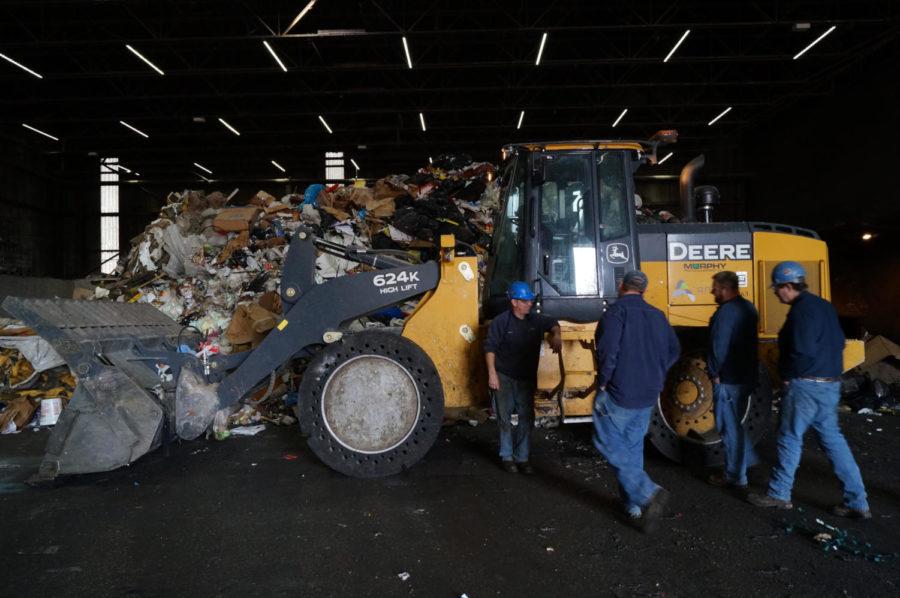Energy production in Ames able to prevent growing landfills
Photo: Jessica Langr/Iowa State D
Workers at Ames Resource Recovery Plant gather at the endloader that hauls and mixes the waste to be processed for energy at the plant on April 3, 2013. The Resource Recovery Plant was established in 1975 and helps keep Ames a sustainable community.
December 6, 2018
While most cities’ trash ends up in a landfill, the City of Ames uses methods to turn its trash into energy.
That’s because the Ames power plant uses something called refuse-derived fuel (RDF), a combustible material produced from Story County’s garbage. This resource recovery serves as the county’s primary method of waste disposal, preventing much of the garbage from ending up in a landfill.
“Landfilling garbage has its own environmental consequences, so (refuse-derived fuel) was looked at as being pretty progressive then,” said Bob Haug, former director of the Iowa Association of Municipal Utilities. “I just don’t know if it still is.”
Ames’ refuse-derived fuel system began in 1975 as a solution to a rapidly-filling landfill. The idea to utilize the city’s waste as a form of fuel was based on a pilot program being tested in St. Louis, which demonstrated the ability to boil water by burning garbage, powering a turbine which could produce electricity. By converting the Ames’ already existing power plant to one which could utilize RDF, Story County’s dependence on landfill was greatly reduced.
Lorrie Hanson, speaking for the city’s Resource Recovery System, said using waste as fuel is as important today as it was when the program began.
“I don’t believe it’s outdated — I believe landfills are outdated,” Hanson said. “The way that these landfills are designed makes it virtually impossible for decomposition to occur within a landfill, and the little [decomposition] that does occur will produce methane for many years to come, passively.”
Hanson said even landfills properly equipped with modern systems release a non-negligible amount of methane in addition to leachate, a liquid created when water mixes with toxic substances leached from the trash. Hanson also said the plant is more heavily regulated than other power plants due to the nature of its fuel.
Haug’s research has focused on the economic aspects of Ames’ power plant, comparing its cost to alternative sources of energy. Iowa is a part of the Midcontinent Independent System Operator (MISO) network, a marketplace for the buying, selling and distribution of energy in areas ranging from Louisiana to Manitoba, Canada. MISO prices energy based on real-time supply and demand, from sources including wind, solar and coal-based systems.
“These numbers are rough, but it’s about 6 cents per kilowatt-hour (kWh) to produce energy at the local power plant with a mixture of natural gas and refuse-derived fuel,” Haug said. “We have to run our power plant in order to be able to burn garbage, and so we’re burning garbage with gas at 6 cents per kWh at times when the market is 3 cents (per kWh).”
He said the average price per kWh on the MISO network was, on average, lower than that of the Ames power plant. On some days, Haug said, the supply of electricity can be high enough that the price per kWh can actually drop below zero.
“On a windy day, or even on a moderately windy day, the state produces more kWh from wind energy than we have uses for or the transmission capacity to export,” Haug said. “We price electricity to make an incentive to decrease production, and so prices actually become negative so that it costs a power producer to put a kWh of electricity on the grid during these periods of high wind production. Those conditions occur quite often in Iowa, and we’re missing the opportunities to purchase at that price.”
Hanson said the price to produce electricity at the local plant may be higher than that of external sources, but said its operation was still critical.
“That’s our charge — we are here to responsibly, sustainably and locally deal with our municipal solid waste,” Hanson said.
While some, like Ames’ Climate Action Team, have called for the city to initiate a recycling program, Hanson said that, since Ames doesn’t have a full recycling facility, the costs and emissions associated with transporting recyclables could be greater than burning it as RDF. She said the best way to reduce the amount of garbage burned at the Ames power plant is for residents to focus on producing less waste.
“Folks need to be more careful about things that they buy, make sure it’s made well so it’ll last a good, long time, and make sure that it is going to adequately meet your needs,” Hanson said. “Don’t buy things that you don’t really need. Americans are horribly consumptive, and we have many, many, many things that we really don’t need. I challenge anybody to look around their residence and say that they don’t have enough stuff.”
Haug said he hopes his work will encourage the city to look at the costs associated with running the RDF plant to determine what path Ames should take going forward.







